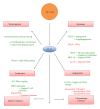The role of interleukin 17 in tumour proliferation, angiogenesis, and metastasis
- PMID: 25110397
- PMCID: PMC4119694
- DOI: 10.1155/2014/623759
The role of interleukin 17 in tumour proliferation, angiogenesis, and metastasis
Abstract
With 7.6 million deaths globally, cancer according to the World Health Organisation is still one of the leading causes of death worldwide. Interleukin 17 (IL-17) is a cytokine produced by Th17 cells, a T helper cell subset developed from an activated CD4+ T-cell. Whilst the importance of IL-17 in human autoimmune disease, inflammation, and pathogen defence reactions has already been established, its potential role in cancer progression still needs to be updated. Interestingly studies have demonstrated that IL-17 plays an intricate role in the pathophysiology of cancer, from tumorigenesis, proliferation, angiogenesis, and metastasis, to adapting the tumour in its ability to confer upon itself both immune, and chemotherapy resistance. This review will look into IL-17 and summarise the current information and data on its role in the pathophysiology of cancer as well as its potential application in the overall management of the disease.
Figures

Similar articles
-
The Role of Interleukin-17 in Lung Cancer.Mediators Inflamm. 2016;2016:8494079. doi: 10.1155/2016/8494079. Epub 2016 Oct 30. Mediators Inflamm. 2016. PMID: 27872514 Free PMC article. Review.
-
IL-17 and colorectal cancer: From carcinogenesis to treatment.Cytokine. 2019 Apr;116:7-12. doi: 10.1016/j.cyto.2018.12.021. Epub 2019 Jan 23. Cytokine. 2019. PMID: 30684916 Review.
-
Interleukin-8 and interleukin-17 for cancer.Cancer Invest. 2014 Jun;32(5):197-205. doi: 10.3109/07357907.2014.898156. Epub 2014 Mar 26. Cancer Invest. 2014. PMID: 24669909 Review.
-
Interleukin-17: The Role for Pathological Angiogenesis in Ocular Neovascular Diseases.Tohoku J Exp Med. 2019 Feb;247(2):87-98. doi: 10.1620/tjem.247.87. Tohoku J Exp Med. 2019. PMID: 30773517 Review.
-
Rationalizing heptadecaphobia: TH 17 cells and associated cytokines in cancer and metastasis.FEBS J. 2021 Dec;288(24):6942-6971. doi: 10.1111/febs.15711. Epub 2021 Jan 29. FEBS J. 2021. PMID: 33448148 Review.
Cited by
-
Beyond immune checkpoint blockade: emerging immunological strategies.Nat Rev Drug Discov. 2021 Dec;20(12):899-919. doi: 10.1038/s41573-021-00155-y. Epub 2021 Mar 8. Nat Rev Drug Discov. 2021. PMID: 33686237 Review.
-
S1P Lyase Regulation of Thymic Egress and Oncogenic Inflammatory Signaling.Mediators Inflamm. 2017;2017:7685142. doi: 10.1155/2017/7685142. Epub 2017 Dec 3. Mediators Inflamm. 2017. PMID: 29333002 Free PMC article. Review.
-
The Mechanism of Bacteroides fragilis Toxin Contributes to Colon Cancer Formation.Malays J Med Sci. 2020 Jul;27(4):9-21. doi: 10.21315/mjms2020.27.4.2. Epub 2020 Aug 19. Malays J Med Sci. 2020. PMID: 32863742 Free PMC article. Review.
-
Transgene-derived overexpression of miR-17-92 in CD8+ T-cells confers enhanced cytotoxic activity.Biochem Biophys Res Commun. 2015 Mar 13;458(3):549-554. doi: 10.1016/j.bbrc.2015.02.003. Epub 2015 Feb 10. Biochem Biophys Res Commun. 2015. PMID: 25677619 Free PMC article.
-
IL-17A and its homologs IL-25/IL-17E recruit the c-RAF/S6 kinase pathway and the generation of pro-oncogenic LMW-E in breast cancer cells.Sci Rep. 2015 Jul 8;5:11874. doi: 10.1038/srep11874. Sci Rep. 2015. PMID: 26154409 Free PMC article.
References
-
- Siegel R, Naishadham D, Jemal A. Cancer statistics, 2013. CA Cancer Journal for Clinicians. 2013;63(1):11–30. - PubMed
-
- Korn T, Bettelli E, Oukka M, Kuchroo VK. IL-17 and Th17 cells. Annual Review of Immunology. 2009;27:485–517. - PubMed
-
- Kolls JK, Linden A. Interleukin-17 family members and inflammation. Immunity. 2004;21(4):467–476. - PubMed
Publication types
MeSH terms
Substances
LinkOut - more resources
Full Text Sources
Other Literature Sources
Research Materials

